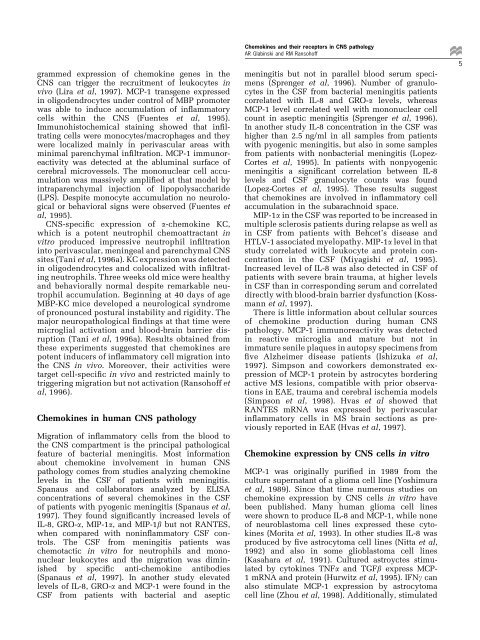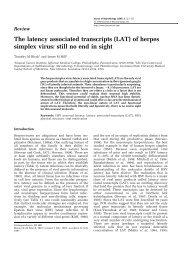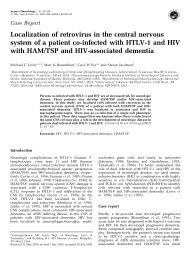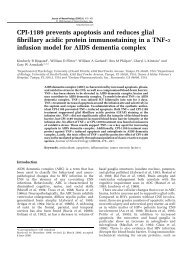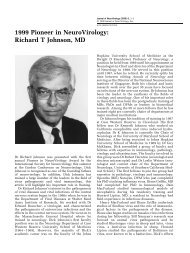Chemokines and chemokine receptors in CNS pathology
Chemokines and chemokine receptors in CNS pathology
Chemokines and chemokine receptors in CNS pathology
Create successful ePaper yourself
Turn your PDF publications into a flip-book with our unique Google optimized e-Paper software.
grammed expression of <strong>chemok<strong>in</strong>e</strong> genes <strong>in</strong> the<br />
<strong>CNS</strong> can trigger the recruitment of leukocytes <strong>in</strong><br />
vivo (Lira et al, 1997). MCP-1 transgene expressed<br />
<strong>in</strong> oligodendrocytes under control of MBP promoter<br />
was able to <strong>in</strong>duce accumulation of <strong>in</strong>¯ammatory<br />
cells with<strong>in</strong> the <strong>CNS</strong> (Fuentes et al, 1995).<br />
Immunohistochemical sta<strong>in</strong><strong>in</strong>g showed that <strong>in</strong>®ltrat<strong>in</strong>g<br />
cells were monocytes/macrophages <strong>and</strong> they<br />
were localized ma<strong>in</strong>ly <strong>in</strong> perivascular areas with<br />
m<strong>in</strong>imal parenchymal <strong>in</strong>®ltration. MCP-1 immunoreactivity<br />
was detected at the ablum<strong>in</strong>al surface of<br />
cerebral microvessels. The mononuclear cell accumulation<br />
was massively ampli®ed at that model by<br />
<strong>in</strong>traparenchymal <strong>in</strong>jection of lipopolysaccharide<br />
(LPS). Despite monocyte accumulation no neurological<br />
or behavioral signs were observed (Fuentes et<br />
al, 1995).<br />
<strong>CNS</strong>-speci®c expression of a-<strong>chemok<strong>in</strong>e</strong> KC,<br />
which is a potent neutrophil chemoattractant <strong>in</strong><br />
vitro produced impressive neutrophil <strong>in</strong>®ltration<br />
<strong>in</strong>to perivascular, men<strong>in</strong>geal <strong>and</strong> parenchymal <strong>CNS</strong><br />
sites (Tani et al, 1996a). KC expression was detected<br />
<strong>in</strong> oligodendrocytes <strong>and</strong> colocalized with <strong>in</strong>®ltrat<strong>in</strong>g<br />
neutrophils. Three weeks old mice were healthy<br />
<strong>and</strong> behaviorally normal despite remarkable neutrophil<br />
accumulation. Beg<strong>in</strong>n<strong>in</strong>g at 40 days of age<br />
MBP-KC mice developed a neurological syndrome<br />
of pronounced postural <strong>in</strong>stability <strong>and</strong> rigidity. The<br />
major neuropathological ®nd<strong>in</strong>gs at that time were<br />
microglial activation <strong>and</strong> blood-bra<strong>in</strong> barrier disruption<br />
(Tani et al, 1996a). Results obta<strong>in</strong>ed from<br />
these experiments suggested that <strong>chemok<strong>in</strong>e</strong>s are<br />
potent <strong>in</strong>ducers of <strong>in</strong>¯ammatory cell migration <strong>in</strong>to<br />
the <strong>CNS</strong> <strong>in</strong> vivo. Moreover, their activities were<br />
target cell-speci®c <strong>in</strong> vivo <strong>and</strong> restricted ma<strong>in</strong>ly to<br />
trigger<strong>in</strong>g migration but not activation (Ransohoff et<br />
al, 1996).<br />
<strong>Chemok<strong>in</strong>es</strong> <strong>in</strong> human <strong>CNS</strong> <strong>pathology</strong><br />
Migration of <strong>in</strong>¯ammatory cells from the blood to<br />
the <strong>CNS</strong> compartment is the pr<strong>in</strong>cipal pathological<br />
feature of bacterial men<strong>in</strong>gitis. Most <strong>in</strong>formation<br />
about <strong>chemok<strong>in</strong>e</strong> <strong>in</strong>volvement <strong>in</strong> human <strong>CNS</strong><br />
<strong>pathology</strong> comes from studies analyz<strong>in</strong>g <strong>chemok<strong>in</strong>e</strong><br />
levels <strong>in</strong> the CSF of patients with men<strong>in</strong>gitis.<br />
Spanaus <strong>and</strong> collaborators analyzed by ELISA<br />
concentrations of several <strong>chemok<strong>in</strong>e</strong>s <strong>in</strong> the CSF<br />
of patients with pyogenic men<strong>in</strong>gitis (Spanaus et al,<br />
1997). They found signi®cantly <strong>in</strong>creased levels of<br />
IL-8, GRO-a, MIP-1a, <strong>and</strong> MIP-1b but not RANTES,<br />
when compared with non<strong>in</strong>¯ammatory CSF controls.<br />
The CSF from men<strong>in</strong>gitis patients was<br />
chemotactic <strong>in</strong> vitro for neutrophils <strong>and</strong> mononuclear<br />
leukocytes <strong>and</strong> the migration was dim<strong>in</strong>ished<br />
by speci®c anti-<strong>chemok<strong>in</strong>e</strong> antibodies<br />
(Spanaus et al, 1997). In another study elevated<br />
levels of IL-8, GRO-a <strong>and</strong> MCP-1 were found <strong>in</strong> the<br />
CSF from patients with bacterial <strong>and</strong> aseptic<br />
<strong>Chemok<strong>in</strong>es</strong> <strong>and</strong> their <strong>receptors</strong> <strong>in</strong> <strong>CNS</strong> <strong>pathology</strong><br />
AR Glab<strong>in</strong>ski <strong>and</strong> RM Ransohoff<br />
men<strong>in</strong>gitis but not <strong>in</strong> parallel blood serum specimens<br />
(Sprenger et al, 1996). Number of granulocytes<br />
<strong>in</strong> the CSF from bacterial men<strong>in</strong>gitis patients<br />
correlated with IL-8 <strong>and</strong> GRO-a levels, whereas<br />
MCP-1 level correlated well with mononuclear cell<br />
count <strong>in</strong> aseptic men<strong>in</strong>gitis (Sprenger et al, 1996).<br />
In another study IL-8 concentration <strong>in</strong> the CSF was<br />
higher than 2.5 ng/ml <strong>in</strong> all samples from patients<br />
with pyogenic men<strong>in</strong>gitis, but also <strong>in</strong> some samples<br />
from patients with nonbacterial men<strong>in</strong>gitis (Lopez-<br />
Cortes et al, 1995). In patients with nonpyogenic<br />
men<strong>in</strong>gitis a signi®cant correlation between IL-8<br />
levels <strong>and</strong> CSF granulocyte counts was found<br />
(Lopez-Cortes et al, 1995). These results suggest<br />
that <strong>chemok<strong>in</strong>e</strong>s are <strong>in</strong>volved <strong>in</strong> <strong>in</strong>¯ammatory cell<br />
accumulation <strong>in</strong> the subarachnoid space.<br />
MIP-1a <strong>in</strong> the CSF was reported to be <strong>in</strong>creased <strong>in</strong><br />
multiple sclerosis patients dur<strong>in</strong>g relapse as well as<br />
<strong>in</strong> CSF from patients with Behcet's disease <strong>and</strong><br />
HTLV-1 associated myelopathy. MIP-1a level <strong>in</strong> that<br />
study correlated with leukocyte <strong>and</strong> prote<strong>in</strong> concentration<br />
<strong>in</strong> the CSF (Miyagishi et al, 1995).<br />
Increased level of IL-8 was also detected <strong>in</strong> CSF of<br />
patients with severe bra<strong>in</strong> trauma, at higher levels<br />
<strong>in</strong> CSF than <strong>in</strong> correspond<strong>in</strong>g serum <strong>and</strong> correlated<br />
directly with blood-bra<strong>in</strong> barrier dysfunction (Kossmann<br />
et al, 1997).<br />
There is little <strong>in</strong>formation about cellular sources<br />
of <strong>chemok<strong>in</strong>e</strong> production dur<strong>in</strong>g human <strong>CNS</strong><br />
<strong>pathology</strong>. MCP-1 immunoreactivity was detected<br />
<strong>in</strong> reactive microglia <strong>and</strong> mature but not <strong>in</strong><br />
immature senile plaques <strong>in</strong> autopsy specimens from<br />
®ve Alzheimer disease patients (Ishizuka et al,<br />
1997). Simpson <strong>and</strong> coworkers demonstrated expression<br />
of MCP-1 prote<strong>in</strong> by astrocytes border<strong>in</strong>g<br />
active MS lesions, compatible with prior observations<br />
<strong>in</strong> EAE, trauma <strong>and</strong> cerebral ischemia models<br />
(Simpson et al, 1998). Hvas et al showed that<br />
RANTES mRNA was expressed by perivascular<br />
<strong>in</strong>¯ammatory cells <strong>in</strong> MS bra<strong>in</strong> sections as previously<br />
reported <strong>in</strong> EAE (Hvas et al, 1997).<br />
Chemok<strong>in</strong>e expression by <strong>CNS</strong> cells <strong>in</strong> vitro<br />
MCP-1 was orig<strong>in</strong>ally puri®ed <strong>in</strong> 1989 from the<br />
culture supernatant of a glioma cell l<strong>in</strong>e (Yoshimura<br />
et al, 1989). S<strong>in</strong>ce that time numerous studies on<br />
<strong>chemok<strong>in</strong>e</strong> expression by <strong>CNS</strong> cells <strong>in</strong> vitro have<br />
been published. Many human glioma cell l<strong>in</strong>es<br />
were shown to produce IL-8 <strong>and</strong> MCP-1, while none<br />
of neuroblastoma cell l<strong>in</strong>es expressed these cytok<strong>in</strong>es<br />
(Morita et al, 1993). In other studies IL-8 was<br />
produced by ®ve astrocytoma cell l<strong>in</strong>es (Nitta et al,<br />
1992) <strong>and</strong> also <strong>in</strong> some glioblastoma cell l<strong>in</strong>es<br />
(Kasahara et al, 1991). Cultured astroyctes stimulated<br />
by cytok<strong>in</strong>es TNFa <strong>and</strong> TGFb express MCP-<br />
1 mRNA <strong>and</strong> prote<strong>in</strong> (Hurwitz et al, 1995). IFNg can<br />
also stimulate MCP-1 expression by astrocytoma<br />
cell l<strong>in</strong>e (Zhou et al, 1998). Additionally, stimulated<br />
5


